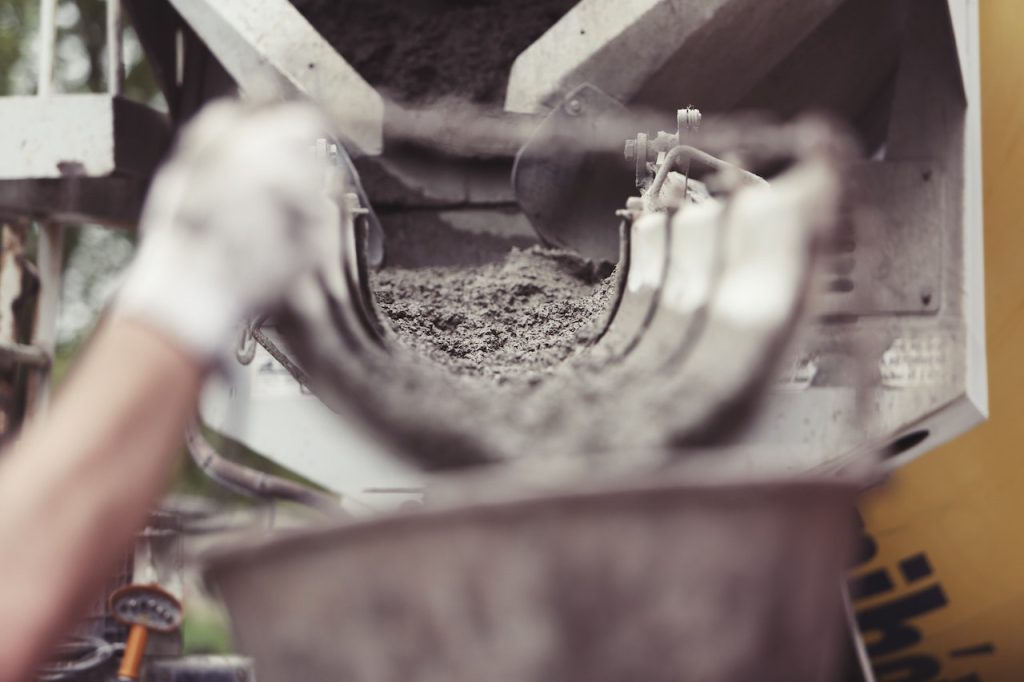Concrete is widely used in all types of construction; from domestic work to multi-storey office blocks and from buildings to bridges.
Concrete is a mixture of ;
Cement
Portland cement is the most common type of cement for construction and when mixed with water, forms a paste. This paste acts like glue and holds or bonds the aggregates together.
Water
Combining water with a cementitious material forms a cement paste by the process of hydration. Less water in the cement paste will yield stronger, more durable concrete; more water will give a freer-flowing concrete with a higher slump. Water must be clean, fresh and free from any dirt, unwanted chemicals or rubbish that can cause problems when setting or in causing premature failure of the structure.
Aggregates
Aggregates are of two basic types:
COARSE: crushed rock, gravel or screenings.
FINE: fine and coarse sands and crusher fines.
Admixtures (if required)
Admixtures are mixed into the concrete to change or alter its properties, ie the time concrete takes to set and harden, or its workability
Chemical admixtures
Chemical admixtures are materials in the form of powder or fluids that are added to the concrete to give it certain characteristics not obtainable with plain concrete mixes. In normal use, admixture dosages are less than 5% by mass of cement and are added to the concrete at the time of batching/mixing.The common types of admixtures are as follows.
- Accelerators speed up the hydration (hardening) of the concrete. Typical materials used are CaCl2, Ca(NO3)2 and NaNO3. However, use of chlorides may cause corrosion in steel reinforcing and is prohibited in some countries and therefore nitrates may be favored.
- Retarders slow the hydration of concrete, and are used in large or difficult pours where partial setting before the pour is complete is undesirable. Typical polyol retarders are sugar, sucrose, sodium gluconate, glucose, citric acid, and tartaric acid.
- Air entrainments add and entrain tiny air bubbles in the concrete, which will reduce damage during freeze-thaw cycles thereby increasing the concrete’s durability. However, entrained air is a trade-off with strength, as each 1% of air may result in 5% decrease in compressive strength.
- Plasticizers increase the workability of plastic or “fresh” concrete, allowing it be placed more easily, with less consolidating effort. Typical plasticizers are lignosulfonate. Plasticizers can be used to reduce the water content of a concrete while maintaining workability, and are sometimes called water-reducers due to this use. Such treatment improves its strength and durability characteristics. Superplasticizers (also called high-range water-reducers) are a class of plasticizers that have fewer deleterious effects, and can be used to increase workability more than practical with traditional plasticizers. Compounds used as superplasticizers include sulfonated naphthalene formaldehyde condensate, sulfonated melamine formaldehyde condensate, acetone formaldehyde condensate, and polycarboxylate ethers.
- Pigments can be used to change the color of concrete, for aesthetics.
- Corrosion inhibitors are used to minimize the corrosion of steel and steel bars in concrete.
- Bonding agents are used to create a bond between old and new concrete.
- Pumping aids improve pumpability, thicken the paste, and reduce separation and bleeding.
Mineral admixtures and blended cements
There are inorganic materials that also have pozzolanic or latent hydraulic properties. These very fine-grained materials are added to the concrete mix to improve the properties of concrete (mineral admixtures), or as a replacement for Portland cement (blended cements).
- Fly ash: A by product of coal fired electric generating plants, it is used to partially replace Portland cement (by up to 60% by mass). The properties of fly ash depend on the type of coal burnt. In general, silicious fly ash is pozzolanic, while calcareous fly ash has latent hydraulic properties.
- Ground granulated blast furnace slag (GGBFS or GGBS): A by-product of steel production is used to partially replace Portland cement (by up to 80% by mass). It has latent hydraulic properties.
- Silica fume: A by-product of the production of silicon and ferrosilicon alloys. Silica fume is similar to fly ash, but has a particle size 100 times smaller. This results in a higher surface-to-volume ratio and a much faster pozzolanic reaction. Silica fume is used to increase strength and durability of concrete, but generally requires the use of superplasticizers for workability.
- High reactivity Metakaolin (HRM): Metakaolin produces concrete with strength and durability similar to concrete made with silica fume. While silica fume is usually dark gray or black in color, high reactivity metakaolin is usually bright white in color, making it the preferred choice for architectural concrete where appearance is important.
Categorization from CSI
Division 3
03000 – Concrete Materials
03010 – Concrete Materials (general)
03020 – Concrete Admixtures
03030 – Concrete Finishing Materials
03100 – Concrete Formwork…
03100 – concrete formwork (general)
03125 – formliners
03200 – Concrete Reinforcement
03200 – Concrete Reinforcement (general)
03203 – Concrete Repair
03240 – Fiber Reinforced Concrete
03250 – Concrete Accessories
03250 – Concrete Accessories (general)
03260 – Cast-in-place Anchors & Inserts
03265 – Waterstops
03275 – Tool-driven Concrete Fasteners
03300 – Cast-In-Place Concrete…
03315 – Concrete Placement Systems & Equipment
03346 – Concrete Crack Control Equipment
03350 – Concrete Finishes
03360 – Specially Placed Concrete
03365 – Post-tensioning Systems
03370 – Concrete Curing
03372 – Nonshrink, Non-Corrosive, Aggregate Grout
03400 – Precast Concrete…
03410 – Precast, insulated foundation wall systems
03412 – Precast, Insulated Foundation Wall Systems
03450 – Architectural Precast Concrete
03490 – Closures & Setting Accessories
03500 – Cementitious Decks…
03500 – Cementitious Decks (general)
03510 – Gypsum Concrete
03600 – Grout
03650 – Cementitious Underlayment
03700 – Concrete Restoration & Cleaning
03800 – Mass Concrete Placement

